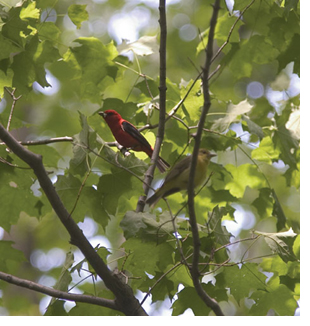Back
 Avian flu pandemic. We never heard of such a thing
a few short years ago. But today, the daily news is rife with
predictions about when the epidemic of avian flu might occur. Avian flu pandemic. We never heard of such a thing
a few short years ago. But today, the daily news is rife with
predictions about when the epidemic of avian flu might occur.
What the U.S. news accounts don’t mention is that
western Pennsylvania could be instrumental in gauging the
possible
spread of this relatively new global health threat here in
the United States. That’s because Powdermill Nature
Reserve, Carnegie Museum of Natural History’s biological
field station in the Laurel Highlands, is participating in
a national
program to test migratory birds for signs of the Avian influenza,
also known as the “bird flu.” The project adds
another proverbial feather to the cap of Powdermill, which
is already recognized for having one of the nation’s
best databases on migratory birds.
Each year, Powdermill’s
2,200 rolling acres are the stop over for thousands of
migrating birds coming and going from
as far away as Asia. And between the spring and fall of
2006, at the request of the U.S. Department of Agriculture,
Powdermill’s
researchers will test about 200 of its visitors for avian
flu.
The disease has made well-publicized inroads into parts
of Asia, Europe, and Africa, killing more than 100 people
and
killing or forcing the slaughter of more than 200 million
chickens, ducks, and other types of domestic fowl. The
global fear is
that the avian flu, which is only transmitted to humans
from contact with infected fowl, will mutate into another
virus
that could be transmitted from human to human. Could it
become a problem here in the United States?
Bob Mulvihill,
Powdermill’s chief ornithologist, is quick
to point out that Avian flu has not been found in North
America, and that it affects waterfowl almost exclusively.
And that’s
one of the important roles Powdermill can play at such
a moment in time: assuring the public they’re safe.
“
There is no health concern associated with continuing to enjoy
wild birds, even around one's home and garden,” Mulvihill
notes. “So you can continue to run bird feeders, attract
birds with bird houses, and even let birds nest on your house
without any fear whatsoever.”
Migration Fact and Mystery
While Powdermill is one of hundreds of bird-banding and
monitoring stations across the country asked to participate
in the monitoring project, it stands out from the pack.
In a recent email to Bob Mulvihill, C. J. Ralph, a research
wildlife biologist with the U.S. Department of Agriculture’s
Forest Service, wrote, “How important are any data
from Powdermill? Your big power is that you have the best
past and present data…at a single station of anybody
in North America.” Ralph, who works at the USDA’s
Pacific Southwest Research Station in California, has been
corresponding with Mulvihill about the Avian flu monitoring
project for months.
To get their test samples, Mulvihill
and his team will swab the inside of each bird’s
cloacal opening, which has both excretory and reproductive
functions, and then
send the samples to a lab for processing. And while this
sounds like a lot of trouble, it isn’t at Powdermill,
where researchers band as many as 300 birds on a typical
day.
Begun in 1961, Powdermill’s banding program
is the longest running of its kind in the United States.
Its avian
researchers catch about 10,000 birds a year in soft nets
strategically hung in a limited section of the reserve—where
they quickly retrieve them and, one-by-one, record the
age, sex, species, weight, body fat, and wing measurements
of each bird (the nets are only up for a limited period
each day). They then put a tiny metal band around one leg
before releasing them again; or, if the bird is already
banded, they update their current records.
The banding takes
all of one minute but the cumulative data it produces gives
evidence of anything but a fly-by-night
operation. Part of Powdermill’s power, in fact, is
that it sits between two major North American migration
routes. The statistical beauty
of its database is the perspective it gives researchers
on a host of issues, ranging from the effects of global
warming to deforestation of the world’s tropical
rain forests to global pollution. And, now, avian flu.
As
Mulvihill puts it: “Unless you have real data,
everything else is conjecture.”
Back
| Top |